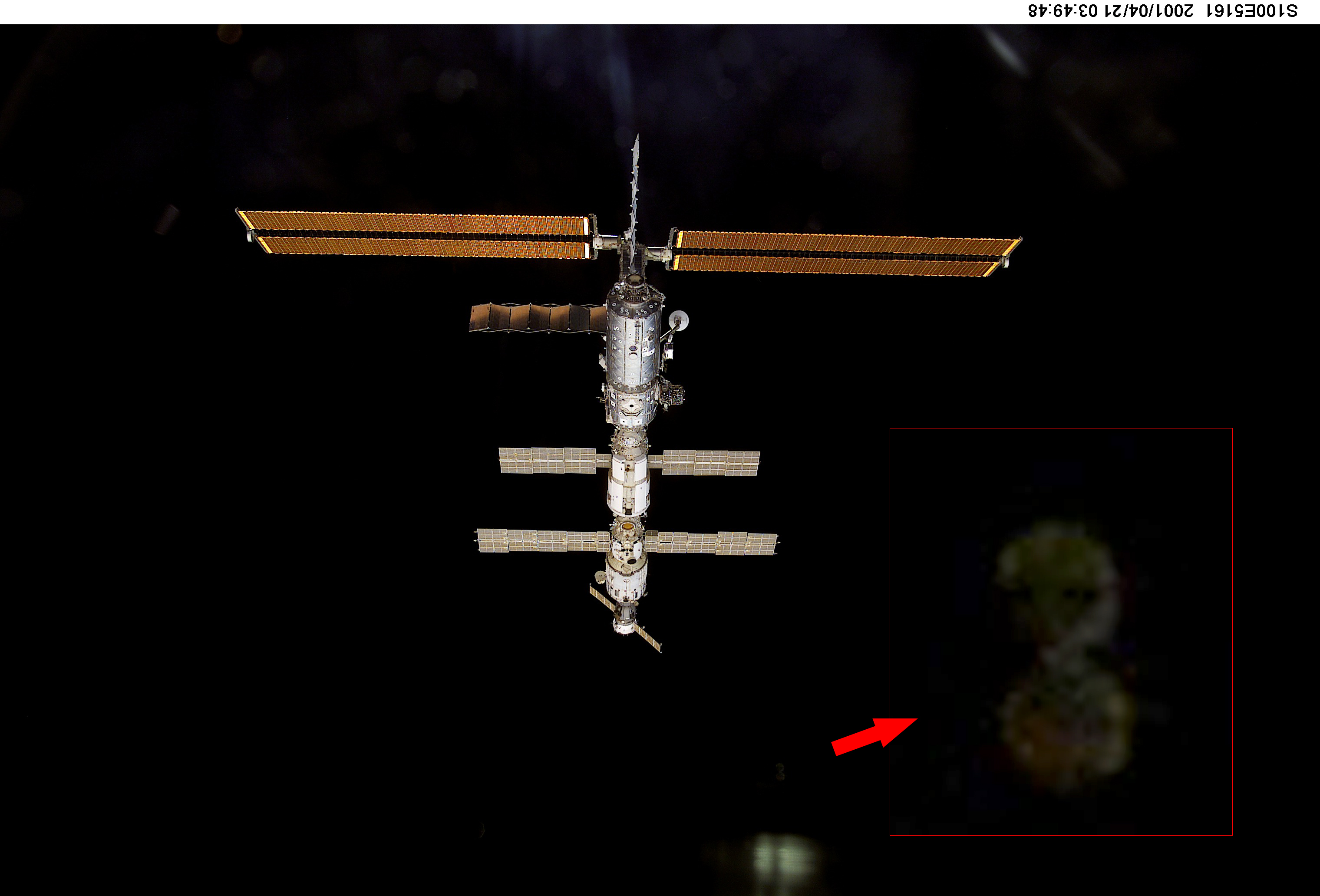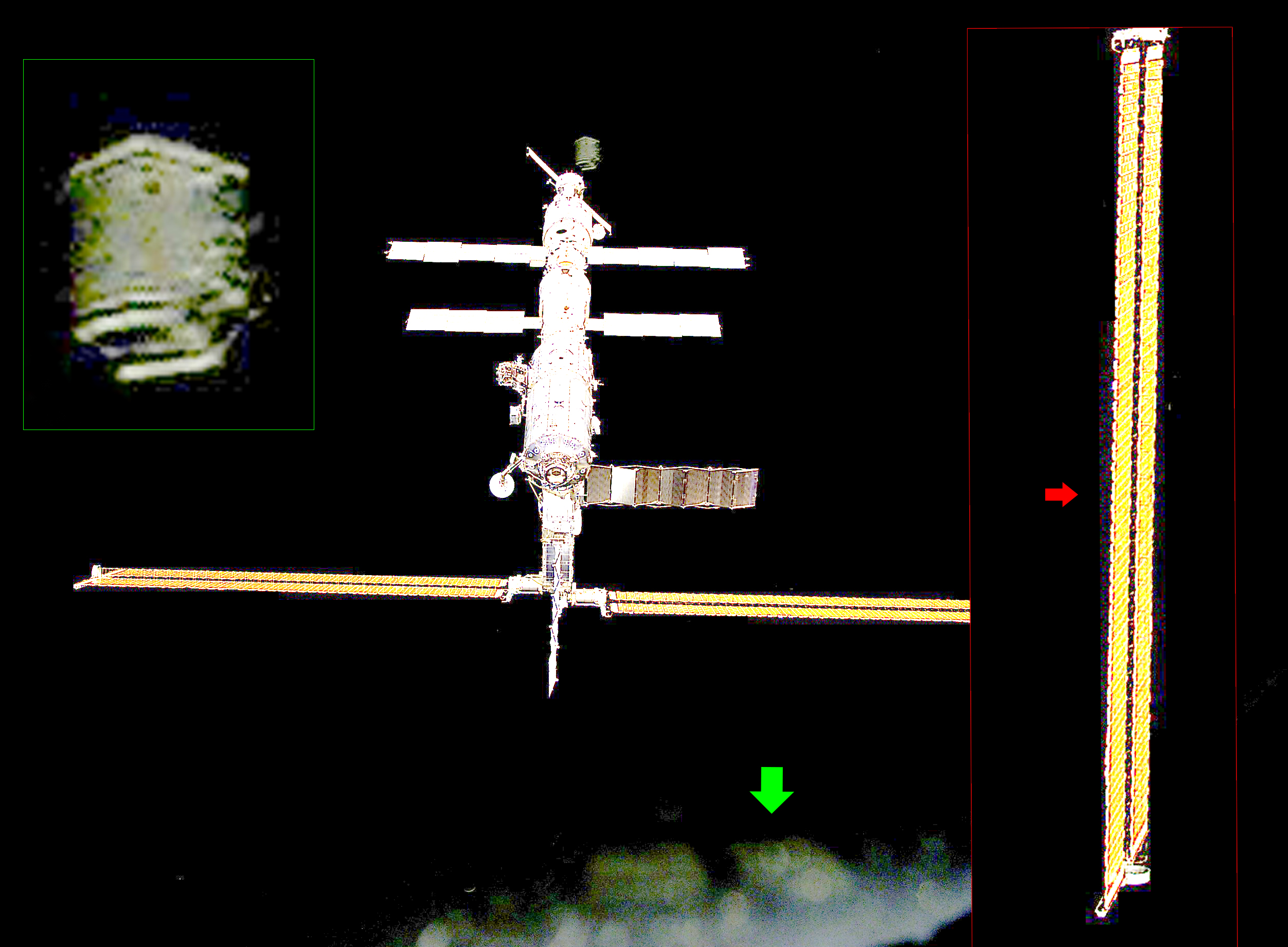It looks like you're using an Ad Blocker.
Please white-list or disable AboveTopSecret.com in your ad-blocking tool.
Thank you.
Some features of ATS will be disabled while you continue to use an ad-blocker.
share:
originally posted by: 0bserver1
a reply to: ArMaP
A camera has multiple shot options, one of them is spot focus/focus spot/spot metering. Meaning its concentrated on the center field, not the surrounding fields and everything on the outside and that's closer to the the camera will be blurred
Really spot focus & focus spot that sounds the same to me, Yes on digital SLR's you can select the focus area but if that was a real object and close to the shuttle then depth of field comes into play and the full length of the ISS is in reasonable focus. There are a few tricks to avoid reflections including turning off lights, getting the lens as close to the window as possible and a cover over the camera/lens to stop stray light hitting the glass.
originally posted by: 0bserver1
a reply to: OrionHunterX
click to enlarge
Besides from reflection or something else, it seems as if the whole ISS is cut and pasted into the scene here, I've brightened the contrast and the straight pixeled lines do not match the rest of the image.
a straightly lined lasso tool is being used for cutting the ISS into the original picture..
the green marker shows how it supposed to be, and the red marker shows cut and pasting to straight pixel lines..
So we have a dowloaded image in jpeg format that has levels altered and saved again as a jpeg the ISS is not a cut and paste.
edit on 15-1-2018
by wmd_2008 because: (no reason given)
I'm usually quick to poke fun at people that think every anomaly ever caught is either magic space dust or some sort of reflection or whatever.
(Seriously, some guys will travel to fantastical lengths, linking several different hypothesis together to make their statement make sense, as they
cannot [and refuse to] even fathom the possibility that we aren't the sole inhabitants of the Universe...).......
........ But in my opinion it really does look like a reflection, maybe of the camera being used to take the picture with the outlines of said person's finger on the side.
........ But in my opinion it really does look like a reflection, maybe of the camera being used to take the picture with the outlines of said person's finger on the side.
If that object were floating in space (such as a resupply module), it's a pretty safe assumption it would be exposed to the same bright sunlight as
the ISS. There's nothing out there that could be casting a shadow to obscure the object, unless it is way off in the distance, it's huge, and it's
in the shadow of the moon.
That leads me to believe it's something not out in space.
That leads me to believe it's something not out in space.
a reply to: TheTruthRocks
The shadow as if I should believe the ISS was really there, came from the ISS. I think looking at the shadows on that thing that maybe those shadows were cast from the " ISS " but honestly I think were seeing two total different scenes here and the unknown object is nothing more than an alien spacecraft..
And this is a projection of an alien being in space!

it's a pretty safe assumption it would be exposed to the same bright sunlight as the ISS
The shadow as if I should believe the ISS was really there, came from the ISS. I think looking at the shadows on that thing that maybe those shadows were cast from the " ISS " but honestly I think were seeing two total different scenes here and the unknown object is nothing more than an alien spacecraft..
And this is a projection of an alien being in space!

a reply to: Chadwickus
Maybe I was wrong, most of the time I find you a hard line skeptic, but yes you did put out those images and that was a great thing to do
Maybe I was wrong, most of the time I find you a hard line skeptic, but yes you did put out those images and that was a great thing to do
a reply to: wmd_2008
I believe they used IR spectra lenses, IMO that means they also capture things that aren't seen by normal vision. And as we know IR shows green on the actual photograph
Now the question arises why, why using advanced optical equipment if you just want to snap something you didn't want the public to know about let alone putting them online?
I believe they used IR spectra lenses, IMO that means they also capture things that aren't seen by normal vision. And as we know IR shows green on the actual photograph
long-wave infrared spectra. IR Lenses are optical lenses that use specific substrates or anti-reflection coatings to maximize performance for applications operating above 700nm including thermal imaging
Now the question arises why, why using advanced optical equipment if you just want to snap something you didn't want the public to know about let alone putting them online?
edit on 0b50America/ChicagoMon, 15 Jan 2018 13:19:50 -0600vAmerica/ChicagoMon, 15 Jan 2018 13:19:50 -06001 by
0bserver1 because: (no reason given)
originally posted by: 0bserver1
I believe they used IR spectra lenses, IMO that means they also capture things that aren't seen by normal vision. And as we know IR shows green on the actual photograph
Two things:
- IR lenses are not enough, the film or sensor must be sensitive to IR. Common digital sensors are sensitive to IR, but, if I'm not mistaken, only to near IR, the closest to the visible wave lengths;
- IR doesn't show as green.
Now the question arises why, why using advanced optical equipment if you just want to snap something you didn't want the public to know about let alone putting them online?
What "advanced optical equipment"? We don't know the characteristics of the camera.
originally posted by: Outlier13
a reply to: skunkape23
lol...do you mean the original machine that had a base plate of prefabulated aluminite, surmounted by a malleable logarithmic casing in such a way that the two main spurving bearings were in a direct line with the pentametric fan? The latter consisted simply of six hydrocoptic marzlevanes, so fitted to the ambifacient lunar waneshaft that side fumbling was effectively prevented. The main winding was of the normal lotus-o-delta type placed in panendermic semi-bovoid slots in the stator, every seventh conductor being connected by a nonreversible tremie pipe to the differential girdlespring on the "up" end of the grammeters.
That's the one!
a reply to: ArMaP
True , so we can only presume that because in space they needed camera's that were IR sensitive to capture more of the whole spectrum of what could be in space other than what was visible on normal camera's.
a reply to: wmd_2008
I think just what ArMaP said we actually don't know what they used so we can speculate all week long what they used or not .
I seem to have a different opinion as you both have and that I can live with . What I see in those pictures deviates from many here , it's not the first time I see those same objects near earth spacecraft and therefore made my own conclusions about those photographs.
a reply to: antar
That we have to make our own conclusions, those with or without us..
What "advanced optical equipment"? We don't know the characteristics of the camera.
True , so we can only presume that because in space they needed camera's that were IR sensitive to capture more of the whole spectrum of what could be in space other than what was visible on normal camera's.
a reply to: wmd_2008
I think just what ArMaP said we actually don't know what they used so we can speculate all week long what they used or not .
I seem to have a different opinion as you both have and that I can live with . What I see in those pictures deviates from many here , it's not the first time I see those same objects near earth spacecraft and therefore made my own conclusions about those photographs.
a reply to: antar
That we have to make our own conclusions, those with or without us..
edit on 0b26America/ChicagoTue, 16 Jan 2018 01:47:26 -0600vAmerica/ChicagoTue, 16 Jan 2018 01:47:26 -06001 by 0bserver1 because: (no reason
given)
originally posted by: 0bserver1
a reply to: ArMaP
What "advanced optical equipment"? We don't know the characteristics of the camera.
True , so we can only presume that because in space they needed camera's that were IR sensitive to capture more of the whole spectrum of what could be in space other than what was visible on normal camera's.
a reply to: wmd_2008
I think just what ArMaP said we actually don't know what they used so we can speculate all week long what they used or not .
I seem to have a different opinion as you both have and that I can live with . What I see in those pictures deviates from many here , it's not the first time I see those same objects near earth spacecraft and therefore made my own conclusions about those photographs.
a reply to: antar
That we have to make our own conclusions, those with or without us..
Actually we can find out if you know were to look or make an effort.
Standard issue cameras on ISS/Shuttle havebeen Nikon cameras for a long time the Kodak DSLR had a Nikon mount so could use Nikon lenses
Cameras used on NASA Missions
The Shuttle had Nikon NASA F4 to start with, the Nikon F4 was a film camera which NASA converted to digital operation. 1 mp 1024x1024 Monochrome CCD sensor. Then Nikon-based Kodak DCS 460, DCS 660 and DCS 760, Nikon D1, D2X, D2Xs, D3, D3X, D3S, D4.
They had IR versions of cameras but colours would not look correct as you will see below.
The Nikon NASA F4 Electronic Still Camera was one of the first and rarest fully digital cameras with development started in 1987. While Nikon delivered a modified Nikon F4 body, most of the electronics for the digital camera and housings were designed and built by NASA at the Johnson Space Center and other suppliers. It was first flown in September 1991 on board the Space Shuttle Discovery, mission STS-48. Later the cameras were flown on several other Shuttle missions[4] including STS-44, 45, 42, 49, 53, 56 and 61.
They then used camers like Nikon D3S, D4s
Digital sensors have an IR fliter attached to them because they are sensitive to IR some more than others.
All sensors used in digital cameras are (to some extent) sensitive to infrared light. This is simple to verify. Standard remote controls uses infrared light to signal the device. Take a TV or DVD remote control, point the remote at your digital camera and push one of the buttons. No visible light can be seen, but if you look at the preview or review of the remote on your camera's LCD screen, you should see the infrared light emitted by the device as a bright spot.
You will even see that with a mobile phone.
IR-light may cause image defects such as flare, false colours, hot spots and chromatic aberrations. It is not a good thing (in an ordinary photograh) to have the image affected by IR-light. As a measure against these defects, an IR-blocking filter in usually placed in the front of the camera's sensor.
I notice no link to the IR lens quote you posted, the cameras are standard DSLR so when they take pictures the colours are correct.
Typical IR shot 790 nm supercolor converted Canon EOS REBEL T3i

edit on 16-1-2018 by wmd_2008 because: (no reason given)
originally posted by: 0bserver1
True , so we can only presume that because in space they needed camera's that were IR sensitive to capture more of the whole spectrum of what could be in space other than what was visible on normal camera's.
If they wanted to use a special camera to get images with more information than what a normal camera shows why use the camera behind a glass? That would limit the camera to the characteristics of the glass, if the glass acts as a IR filter, for example, they wouldn't get any IR with their "special camera".
originally posted by: ArMaP
originally posted by: 0bserver1
True , so we can only presume that because in space they needed camera's that were IR sensitive to capture more of the whole spectrum of what could be in space other than what was visible on normal camera's.
If they wanted to use a special camera to get images with more information than what a normal camera shows why use the camera behind a glass? That would limit the camera to the characteristics of the glass, if the glass acts as a IR filter, for example, they wouldn't get any IR with their "special camera".
Just what I was thinking -- the cupola windows are probably treated to reduce IR and UV transmissivity, I have the charts for shuttle windows but never bothered to get ISS window characteristics. Should be easy enough to FOIA.
Even as far back as Skylab, crew windows were narrow-band, to get UV photos of Comet Kohoutek the crew actually had to go outside on an EVA.
Shuttle Columbia did have an optically flat UV-transparent middeck hatch window for specific scientific observations, at other times there was a UV filter attached over it. I was told that if the filter wasn't installed, even scattered light from naked sunlight streaming inside could induce retinal damage ['snow blindness;] within 15 minutes.
And as you Can see the reflected object is out of focues.
its to close!
So it Can Not be the camra.
its to close!
So it Can Not be the camra.
originally posted by: 0bserver1
a reply to: ArMaP
NASA
Yeah, you're probably right.
a reply to: Chadwickus
Thanks, mate for them links, I shouldn't look deep into these photographs, you never know who's reflection shows up?
peekaboo
a reply to: ArMaP
Not if you use external filters. And you don't know what IR will be blocked by those windows ?
Short wave or long wave IR ? Short wave can be seen through glass on camera's with IR lenses
Not if you use external filters. And you don't know what IR will be blocked by those windows ?
Short wave or long wave IR ? Short wave can be seen through glass on camera's with IR lenses
edit on 0b55America/ChicagoTue, 16 Jan 2018
17:51:55 -0600vAmerica/ChicagoTue, 16 Jan 2018 17:51:55 -06001 by 0bserver1 because: (no reason given)
new topics
-
Mike Pinder The Moody Blues R.I.P.
Music: 36 minutes ago -
Putin, Russia and the Great Architects of the Universe
ATS Skunk Works: 3 hours ago -
A Warning to America: 25 Ways the US is Being Destroyed
New World Order: 8 hours ago
top topics
-
President BIDEN's FBI Raided Donald Trump's Florida Home for OBAMA-NORTH KOREA Documents.
Political Conspiracies: 13 hours ago, 31 flags -
A Warning to America: 25 Ways the US is Being Destroyed
New World Order: 8 hours ago, 13 flags -
Is AI Better Than the Hollywood Elite?
Movies: 15 hours ago, 4 flags -
Mike Pinder The Moody Blues R.I.P.
Music: 36 minutes ago, 2 flags -
Maestro Benedetto
Literature: 15 hours ago, 1 flags -
Putin, Russia and the Great Architects of the Universe
ATS Skunk Works: 3 hours ago, 1 flags
active topics
-
Meadows, Giuliani Among 11 Indicted in Arizona in Latest 2020 Election Subversion Case
Mainstream News • 15 • : IndieA -
Putin, Russia and the Great Architects of the Universe
ATS Skunk Works • 13 • : CriticalStinker -
Alternate Electors vs Fake Electors - What is the Difference.
2024 Elections • 120 • : Threadbarer -
Gaza Terrorists Attack US Humanitarian Pier During Construction
Middle East Issues • 58 • : matafuchs -
Truth Social goes public, be careful not to lose your money
Mainstream News • 132 • : matafuchs -
New whistleblower Jason Sands speaks on Twitter Spaces last night.
Aliens and UFOs • 67 • : Ophiuchus1 -
Mike Pinder The Moody Blues R.I.P.
Music • 1 • : RussianTroll -
Mood Music Part VI
Music • 3106 • : TheWoker -
University of Texas Instantly Shuts Down Anti Israel Protests
Education and Media • 275 • : Vermilion -
President BIDEN's FBI Raided Donald Trump's Florida Home for OBAMA-NORTH KOREA Documents.
Political Conspiracies • 22 • : 320MPH


